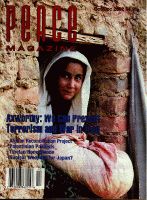
Peace Magazine Oct-Dec 2002, page 29. Some rights reserved.
Search for other articles by Andrew Brink here
Lloyd Demause New York, London: Karnac, 2002
Lloyd deMause's The Emotional Life of Nations is a major contribution to understanding peace and war. It presents four decades of psycho-social research and writing on how "most of human violence" results from "a hidden children's holocaust throughout history." DeMause's far-ranging and scholarly demonstration is highly distressing, and even seasoned readers may turn it aside as too awful to contemplate. But The Emotional Life of Nations is neither pessimistic nor fatalistic, marking a great advance over earlier statements by psychoanalysts from Freud's "Thoughts for the Times on War and Death" (1915) to Anthony Storr's Human Aggression (1968).
DeMause has done more systematic research in the history of childhood, and thought more critically, than anyone before him. He does not think that we are doomed by innate aggression to endless warfare. His analysis of the childhood origins of anxiety, anger and aggression as preconditions for war takes some getting used to, and one must persevere through a 432 page book to do so. There will be occasional sticking points along the way, but the main thesis seems incontrovertible.
Historians seldom enquire into the basic motivations to war, acquiescing in von Clausewitz's view that wars are simply political acts continuing diplomacy by other means. Historians are too taken up with the posturing, speech-making and maneuvering of politicians and military leaders to see that entire populations sometimes need wars for unstated reasons. The unstated reasons are to be found in "group fantasies" of inadequacy, guilt and neediness. These collective states of mind, in turn, arise from neglectful and, especially, abusive conditions of child rearing typically found in a society. Evidence for abusive child rearing is often hard to come by, and the strength of deMause's book is how fully it succeeds in assembling historical case studies. Readers wanting to test deMause's plausibility should look at p182f. on "The Causes of World War II and the Holocaust", where he assembles evidence for beating, terrorizing and sexually molesting German children as the precondition for their active, or passive, participation in persecutions of Jews and other minorities and in suicidal war. (This is the same ground covered by Alice Miller's For Your Own Good: Hidden Cruelty in Child-Rearing and the Roots of Violence (1983), but deMause's account is more scholarly and searching.)
It will be a new departure for many peace researchers and activists to read deMause. The book should not be dismissed because Freudian psychoanalysis has ceased to be a force in culture. DeMause moves with the times, presenting the most recent research into trauma and neuro-chemistry to support his claims. There are new findings in Attachment Theory research to further support his findings, had he chosen to include them; but such lacunae are few. Some of his discussions, for instance on fetal trauma, may seen speculative, but it is well to have them included for what verifications may arise in future studies. Mainly the book is documentary, with all the apparatus of close scholarship, and its theory is easily carried. The emphasis throughout is positive. He writes: "Although these conclusions about the relative permanence of early trauma and its restaging in war, social violence, and economic injustice admittedly are discouraging, an awareness of the source of human violence can actually be enormously hopeful." (pp. 84-5) Prevention of early trauma is the concluding topic. Seldom have there been contributions of this magnitude made to the problem of why pointless and destructive wars are so hard to foresee and avert.
The book may be ordered from the Institute of Psychohistory, 140 Riverside Dr., New York, N.Y., 10024 @ US 45.00 plus 1.75 shipping. It is also available online at www.psychohistory,com.
Reviewed by Andrew Brink, a retired McMaster U. English professor.

Peace Magazine Oct-Dec 2002, page 29. Some rights reserved.
Search for other articles by Andrew Brink here